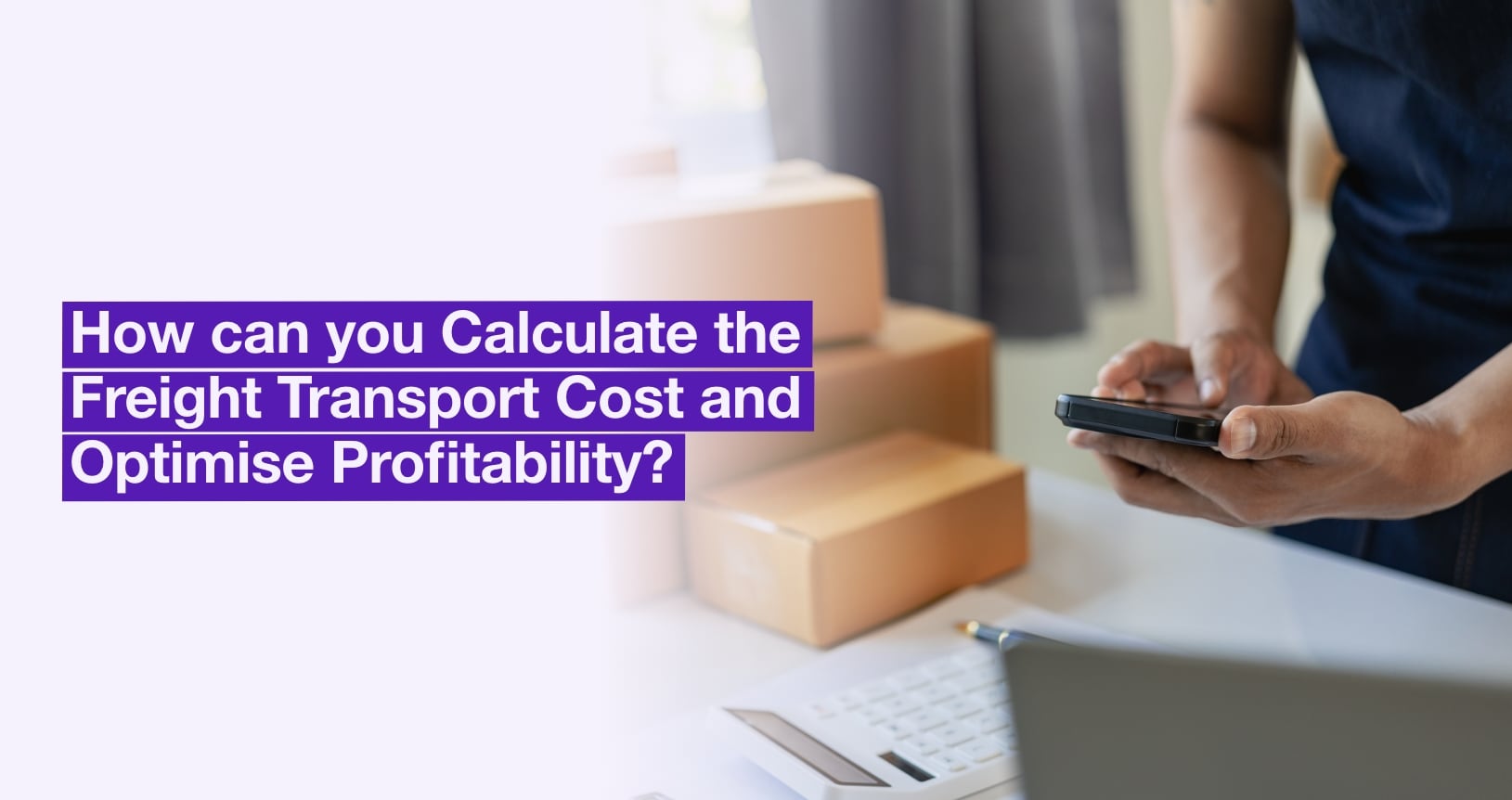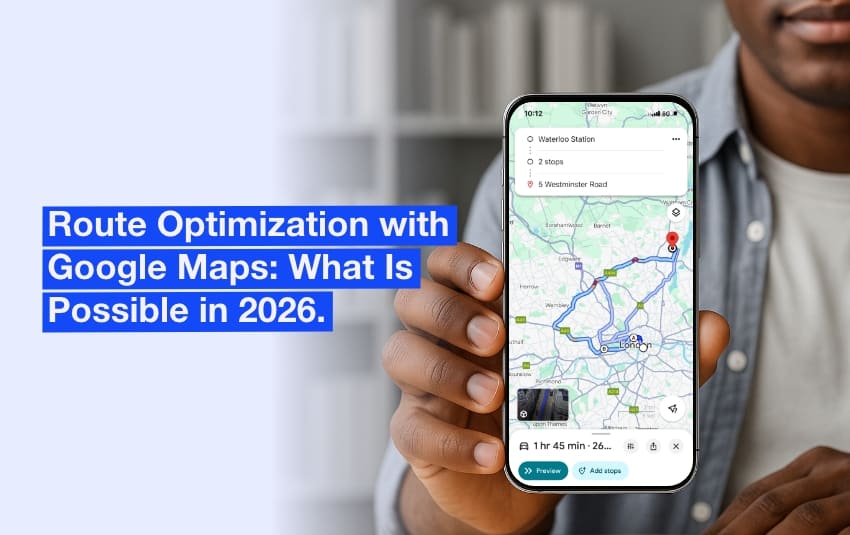How can you Calculate the Freight Transport Cost and Optimise Profitability?
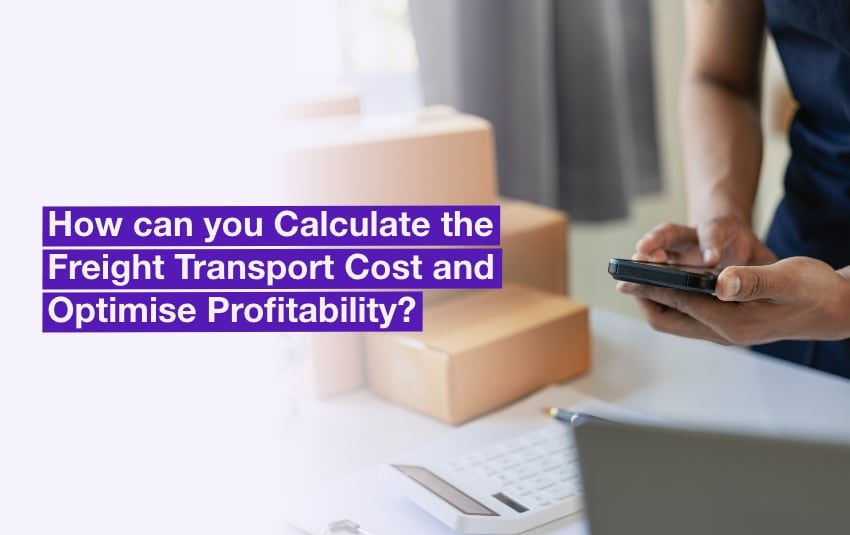
Transport accounts for up to 25% of a company’s logistics costs, yet 78% of logistics managers struggle to keep them under control. Between rising fuel prices, regulatory constraints and pressure on margins, calculating transport costs correctly has become a strategic challenge.
Why is it so important? Inaccurate cost estimates can affect rate of return, distort selling prices and complicate resource management. While transport companies generally have advanced analytical tools at their disposal, those for whom transport is not their core business often lack visibility over their expenditure.
This article offers you a clear and accessible method for accurately assessing your transport costs and identifying the levers for optimisation.
Table of contents:
- Understanding the components of transport costs
- The essential formulae for calculating your transport costs
- Key factors influencing your transport costs
- How do you calculate your transport costs?
- Optimisation strategies to reduce your transport costs
- Tools and solutions to simplify cost monitoring
Understanding the components of transport costs
Before looking to optimise your expenditure, it is essential to understand its structure. The cost of transport is not limited to fuel: it includes fixed, variable and indirect expenses, which have a direct impact on your profitability.
These costs remain constant, regardless of the number of kilometres travelled or the volume transported. They must be spread over your entire activity:
- Vehicle depreciation: Purchase, long-term rental or leasing.
- Insurance and taxes: Third-party liability, axle tax, environmental contributions.
- Driver salaries: Independent of the number of deliveries made.
Variable costs: linked to day-to-day operations
Conversely, these costs vary according to vehicle use and business volume.
- Fuel: Major item of expenditure.
- Maintenance and repairs: Tyres, oil changes, mechanical parts, roadworthiness tests.
- Tolls and ancillary costs: Additional costs associated with long-distance journeys or restricted traffic zones.
Indirect costs: often underestimated
Although these costs are less visible, they do weigh on your transport budget:
- Administrative costs: Route planning, managing invoices and disputes.
- Fleet management: Cost of tracking software, driver training, equipment replacement.
- Hidden costs: Delivery delays, customer dissatisfaction, driver turnover.
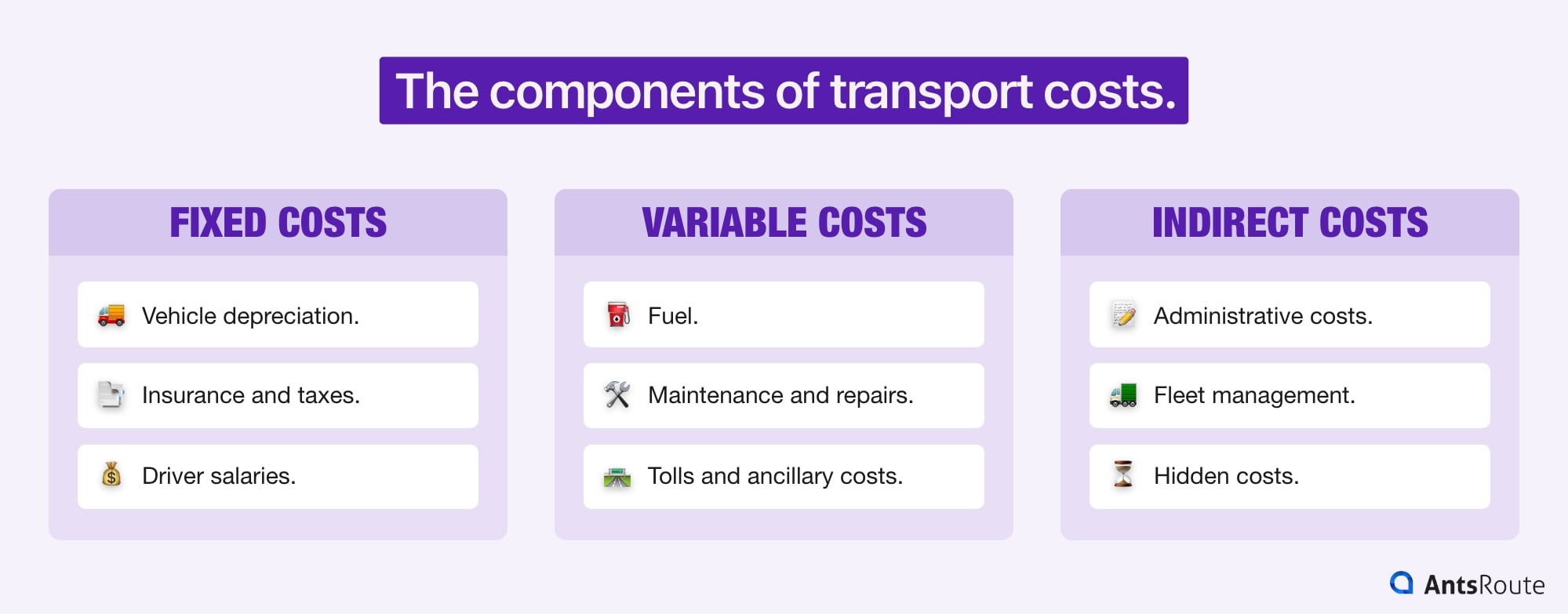
The components of transport costs.
The essential formulae for calculating your transport costs
Once you’ve identified the various expense items, how do you accurately quantify your transport costs? There are several methods of calculation, adapted to the level of precision required and the type of activity.
The basic formula: simple and effective
The most common method is to add fixed costs and variable costs:
Total cost = Fixed costs + Variable costs
Why use it? Ideal for an initial estimate, this approach is perfectly suited to small businesses that want to quickly assess their overall expenditure.
Calculating cost per kilometre: measuring journey efficiency
This indicator can be used to assess the average cost of a journey and identify areas for optimisation.
Formula:
Cost per kilometre = Total cost / Total number of kilometres travelled
Let’s take a concrete example: if your total monthly cost is €10,000 and you have travelled 4,000 kilometres, your cost per kilometre is €2.50/km (€10,000/4,000 km = €2.50/km).
Calculating the cost per tonne-kilometre: the key indicator for heavy goods vehicles
For companies transporting heavy goods, it makes sense to include the weight transported in the cost analysis.
Formula:
Cost per tonne-kilometre = Total cost / (Total number of tonnes transported x Distance in kilometres)
A concrete example: If your total cost is €2,000, and you transported 50 tonnes over 200 kilometres, then your cost per tonne-kilometre is €0.20/tonne-km (€2,000/(50 tonnes x 200 km) = €0.20/tonne-km).
Why use it? This indicator is essential for assessing the profitability of long-distance transport and for negotiating rates more effectively with customers or carriers.
That’s it, the basis for the calculation is there! Now it’s time to take a look at the factors that influence costs.
Key factors influencing your transport costs
Many factors have an impact on the cost of transport, far beyond the simple price of fuel. Here are the main ones to bear in mind:
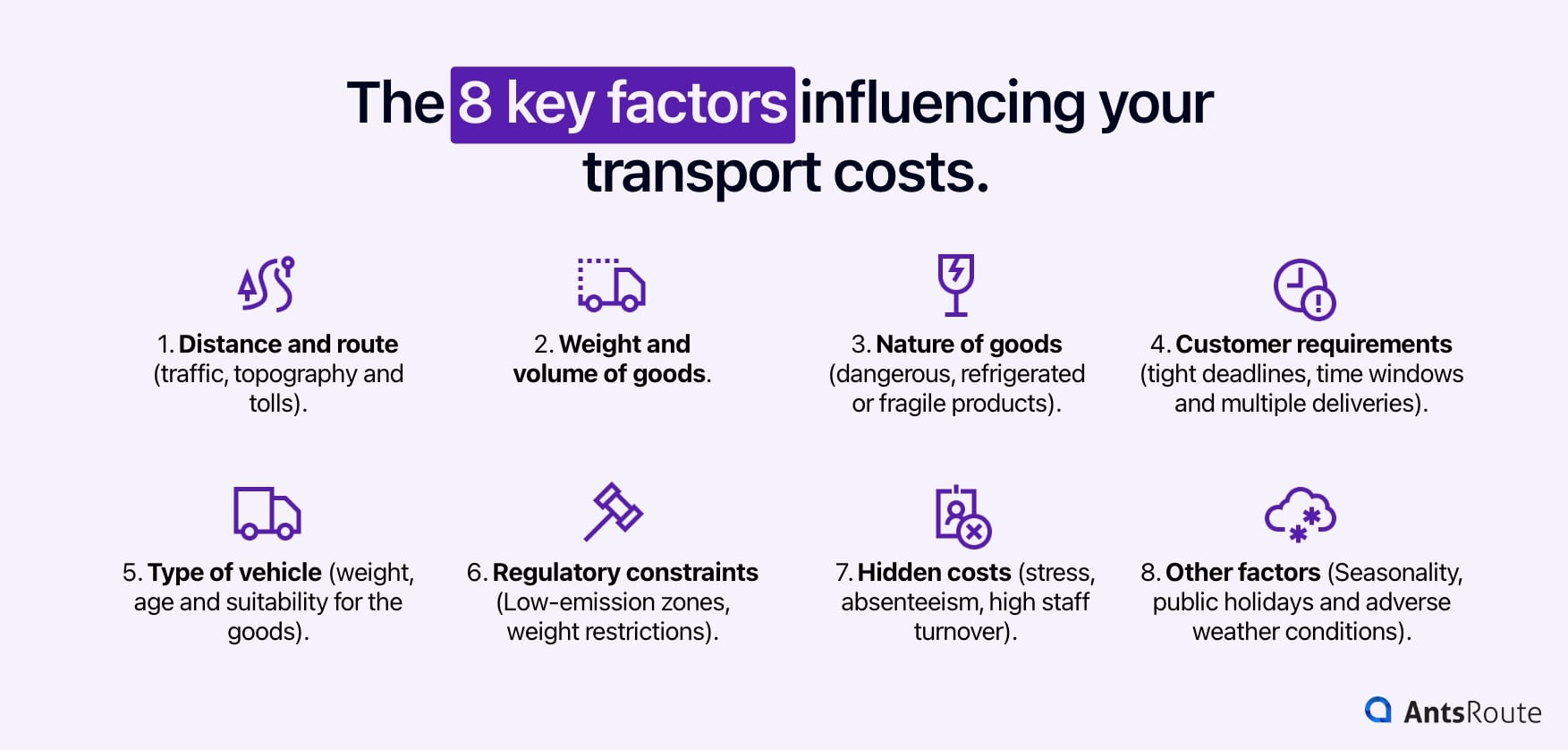
- Distance and route: As well as distance, traffic, topography and tolls all have an impact on costs. A motorway route, although more expensive in terms of tolls, can be more economical in terms of fuel than a longer, winding secondary road.
- Weight and volume of goods: A heavy load increases fuel consumption, while an inefficient layout reduces capacity and requires additional journeys.
- Nature of goods: Dangerous, refrigerated or fragile products require specific equipment and appropriate insurance.
- Customer requirements: Tight deadlines, time windows and multiple deliveries add to the bill. Optimisation using tools like AntsRoute can reduce these constraints.
- Type of vehicle: Its weight, age and suitability for the goods influence costs. A recent or electric model can offer long-term savings.
- Regulatory constraints: Low-emission zones, weight restrictions and driving times often impose significant additional costs.
- Hidden costs: Driver stress and absenteeism, high staff turnover or loss of customers due to delays all have an impact on profitability.
- Other factors: Seasonality, public holidays and adverse weather conditions also influence logistics costs.
How do you calculate your transport costs?
Calculating your transport costs accurately is not just a simple formula. It’s a structured process, based on several essential steps.

The 4 stages to calculate your transport costs.
Stage 1: Data collection
A good analysis is based on accurate and complete data. Here is the main information to gather:
- Fleet data: Number of vehicles, type, average fuel consumption.
- Annual mileage: Total driven per vehicle or per route.
- Fixed and variable costs: Drivers’ salaries, maintenance, fuel, tolls, etc.
- Carrier rates (if subcontracted): Cost per km, ancillary costs.
- Fill rates and volumes transported: Essential for refining calculations.
☝️ Recommended tool: Route management software such as AntsRoute can automate data collection and provide detailed analyses.
Stage 2: Analysis of fixed costs
Once the data has been collected, it is necessary to isolate and allocate the fixed costs, which represent around 30% of transport costs.
How are they calculated?
- Add up all your annual fixed costs.
- Divide this total by the number of days the vehicles are used to obtain a daily fixed cost.
- Break down these costs by vehicle, month or cost centre.
Example: A company with annual fixed costs of €400,000 and 2000 days of use will have a fixed cost of €200 (€400,000/2000).
Stage 3: Evaluation of variable costs
Monitoring variable costs is essential for anticipating fluctuations and adjusting rates accordingly.
- Fuel tracking: Record fuel consumption and cost per journey.
- Track maintenance costs: Keep invoices and details of repairs.
- Estimate toll costs: Use online toll calculators.
Example: For a 500 km journey, we could have €200 in fuel, €40 in tolls and €20 in estimated maintenance costs, giving a total of €260 in variable costs.
Stage 4: Calculation of total cost and cost per unit
Once the fixed and variable costs have been calculated, it is possible to calculate the total cost and the cost per unit, using the formulas mentioned above.
Formulae:
- Total cost = Fixed costs + Variable costs
- Cost per kilometre = Total cost / Number of kilometres travelled
- Cost per tonne-kilometre = Total cost / (Number of tonnes transported x Distance in kilometres)
Example: €200 (daily fixed costs) + €260 (variable costs) = €460.
☝️ Tip: Organise your data in tables to make it easier to analyse and monitor costs.
Calculating costs is an essential first step…but optimising your transport is even more strategic! Let’s take a look at the best practices for reducing your expenditure.
Optimisation strategies to reduce your transport costs
Here are the best practices for optimising your expenditure:
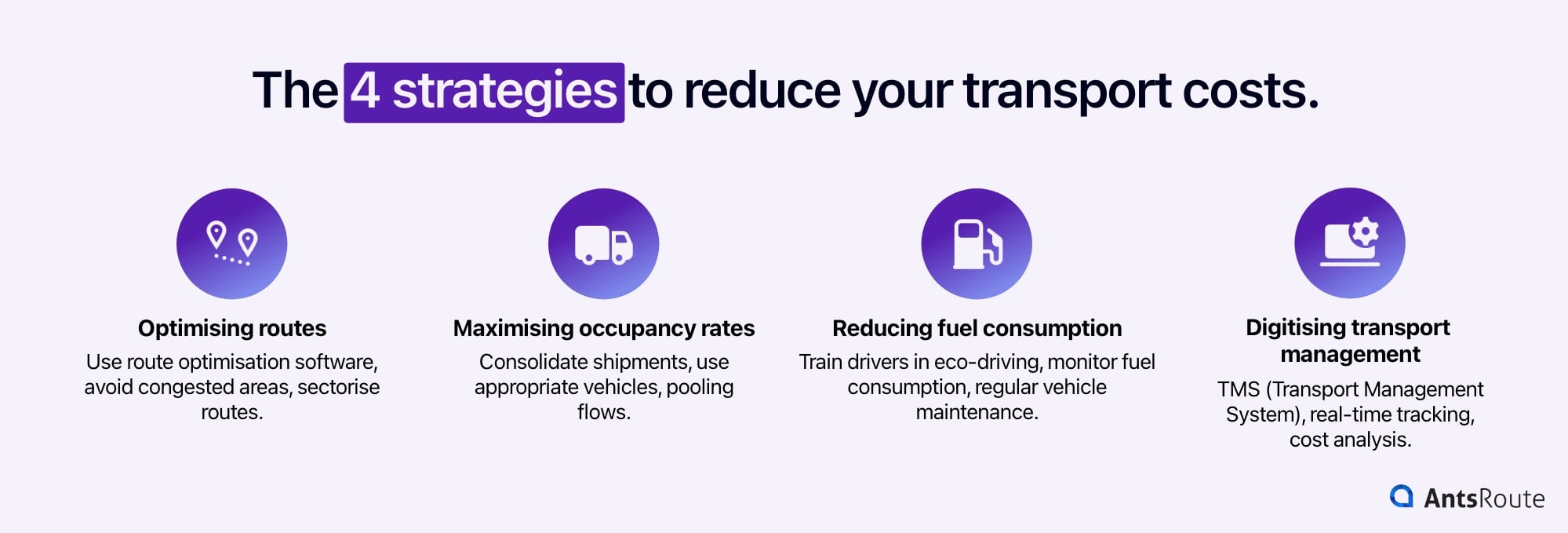
The 4 strategies to reduce your transport costs.
Optimising routes
A poorly planned itinerary leads to over-consumption of fuel, wasted time and premature wear and tear on vehicles.
- Use route optimisation software: AntsRoute automatically calculates the shortest route based on constraints (deliveries, timetables, road restrictions).
- Avoid congested areas: Even without software, tools such as Google Maps or Waze can help you identify the fastest routes and avoid traffic jams. Traffic jams increase fuel consumption and driver waiting times.
- Sectorise routes: Allocating specific zones to drivers reduces unnecessary mileage.
Maximising occupancy rates
A poorly filled truck costs more per kilometre. Making better use of space reduces unit costs per delivery.
- Consolidate shipments: Group several deliveries together to limit unnecessary journeys.
- Use appropriate vehicles: A van is more cost-effective for local deliveries than an under-utilised lorry.
- Pooling flows: Working with other carriers means you can share loads and avoid empty returns.
Reducing fuel consumption
- Train drivers in eco-driving: Smooth driving, without sudden acceleration and with good use of engine braking, saves fuel.
- Monitor fuel consumption: A system for monitoring driver performance helps to identify areas for improvement.
- Regular vehicle maintenance: Preventive maintenance helps to maintain fuel efficiency and avoid costly breakdowns.
Digitising transport management
Digital tools make it possible to centralise information, automate processes and avoid human error.
- TMS (Transport Management System): Logistics flow management software facilitates planning and performance analysis.
- Real-time tracking: GPS, vehicle tracking and mobile applications enable routes to be adjusted live.
- Cost analysis: solutions such as AntsRoute calculate the cost of routes in real time and identify areas for optimisation.

Digital tools make it possible to centralise information and automate processes.
Tools and solutions to simplify cost monitoring
Calculating and tracking transport costs can quickly become complex and time-consuming. So rather than doing these calculations by hand, we recommend using specialist tools.
Specialised spreadsheets: A simple and accessible solution
If you’re just starting out or running a small business, spreadsheets such as Excel or Google Sheets are still an essential option.
- Pre-configured models: Available online, often free or at low cost, they include formulas for calculating fixed and variable costs and cost per kilometre.
- Advanced features: Graphs, pivot tables and complex calculation functions for clear data visualisation.
☝️ Ideal for initial manual monitoring before opting for an automated solution!
TMS software: optimised transport management
TMSs are advanced solutions for comprehensive cost management and optimisation of logistics flows.
- Centralised data: Costs, routes, vehicles, drivers and customers all in one platform.
- Automated calculations: Fewer manual entries, fewer errors and considerable savings.
- Real-time monitoring: Continuous monitoring of costs and the ability to make immediate adjustments in the event of unforeseen circumstances.
- Performance analysis: Detailed reports and dashboards to identify areas for improvement.
☝️ AntsRoute includes a function for calculating route costs, turnover and margins.
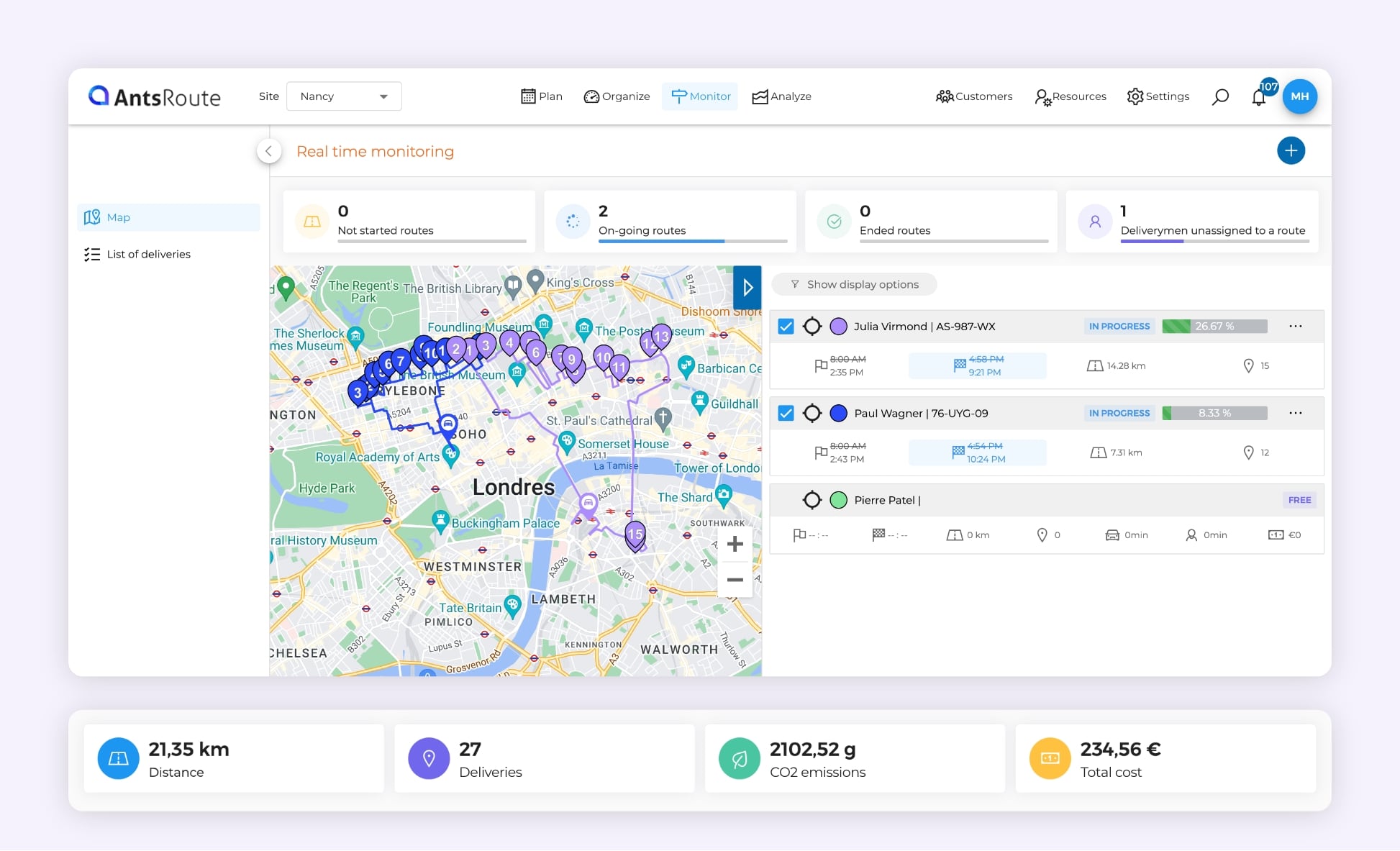
The AntsRoute route optimisation software.
AntsRoute: A powerful lever for optimising your transport costs
By adopting AntsRoute, you can significantly reduce your operational costs.
- Fewer kilometres, more savings: The mobile teams of customers of Ocean Orange Business Services have reduced the distances they travel by 20%, resulting in a 35% reduction in social and environmental costs.
- Boosted productivity and controlled costs: Help Air à Domicile has benefited from productivity gains of 15 to 30%, while optimising its costs and reducing its CO2 emissions.
- More efficient management and accurate data: For Licorne Express, the software has transformed delivery management. According to its founder, Maïté Galou, AntsRoute offers complete visibility of performance, such as the number of deliveries per hour and per courier, making it easier to take decisions.
Take action today:
- ✅ Evaluate your transport costs using the methodology presented.
- ✅ Test AntsRoute for free for 7 days and optimise your routes!
- ✅ Share your experience: What method do you currently use to calculate your transport costs?
WRITTEN BY

Florine Martin
Florine has been a freelance web copywriter since 2021, writing for a variety of clients in a range of sectors. Since the beginning of 2024, she has been writing articles about logistics for our company, AntsRoute.
Free 7-day trial | No credit card required
Contenu
- Understanding the components of transport costs
- Fixed costs: unavoidable expenses
- Variable costs: linked to day-to-day operations
- Indirect costs: often underestimated
- The essential formulae for calculating your transport costs
- The basic formula: simple and effective
- Calculating cost per kilometre: measuring journey efficiency
- Calculating the cost per tonne-kilometre: the key indicator for heavy goods vehicles
- Key factors influencing your transport costs
- How do you calculate your transport costs?
- Stage 1: Data collection
- Stage 2: Analysis of fixed costs
- Stage 3: Evaluation of variable costs
- Stage 4: Calculation of total cost and cost per unit
- Optimisation strategies to reduce your transport costs
- Optimising routes
- Maximising occupancy rates
- Reducing fuel consumption
- Digitising transport management
- Tools and solutions to simplify cost monitoring
- Specialised spreadsheets: A simple and accessible solution
- TMS software: optimised transport management
- AntsRoute: A powerful lever for optimising your transport costs

